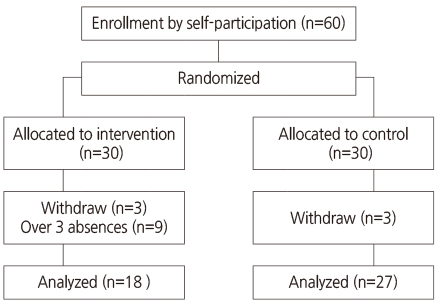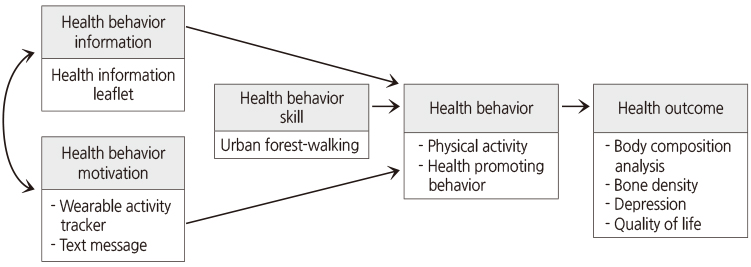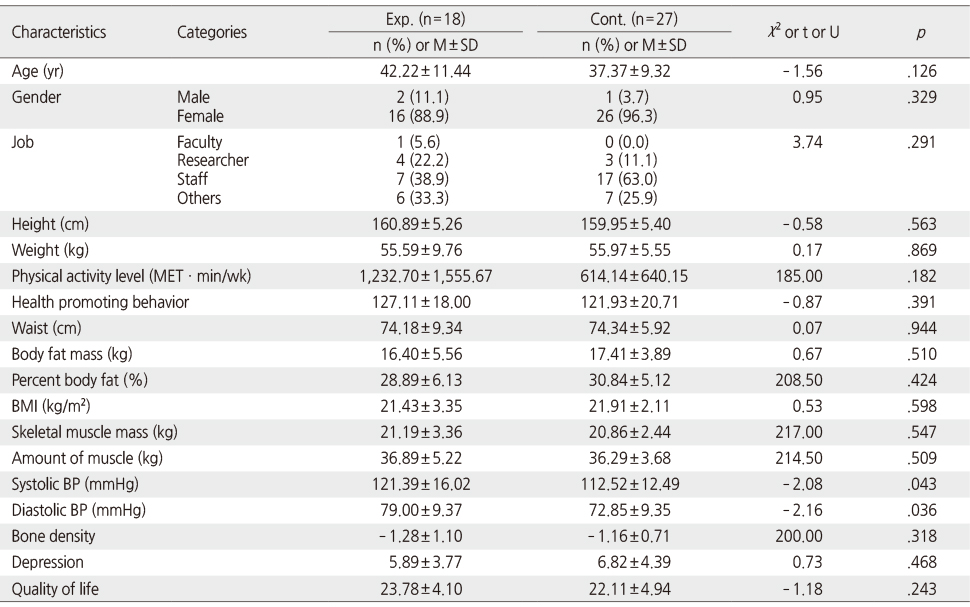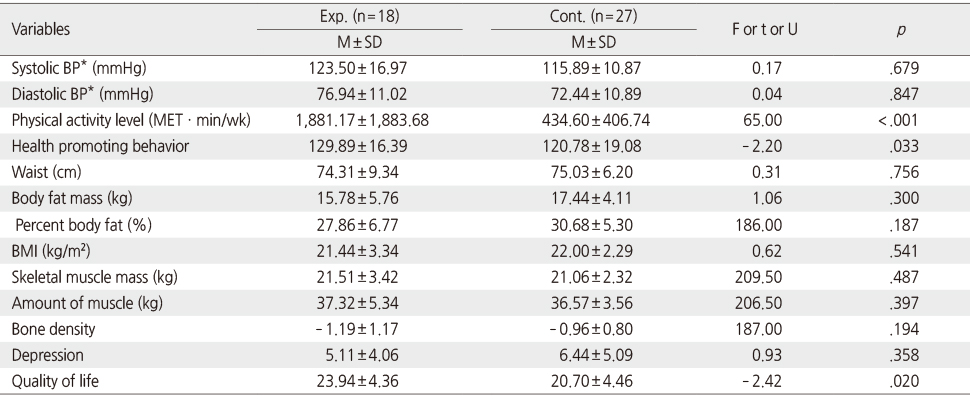Articles
- Page Path
- HOME > J Korean Acad Nurs > Volume 46(1); 2016 > Article
-
Original Article
- The Effects of Urban Forest-walking Program on Health Promotion Behavior, Physical Health, Depression, and Quality of Life: A Randomized Controlled Trial of Office-workers
- Kyung-Sook Bang, In-sook Lee, Sung-Jae Kim, Min Kyung Song, Se-Eun Park
-
Journal of Korean Academy of Nursing 2016;46(1):140-148.
DOI: https://doi.org/10.4040/jkan.2016.46.1.140
Published online: February 29, 2016
1College of Nursing·The Research Institute of Nursing Science, Seoul National University, Seoul, Korea.
2College of Nursing, Seoul National University, Seoul, Korea.
- Address reprint requests to: Song, Min Kyung. College of Nursing·Seoul National University, 103 Daehak-ro, Jongno-gu, Seoul 03080, Korea. Tel: +82-2-740-8467, Fax: +82-2-765-4103, mk0408@snu.ac.kr
© 2016 Korean Society of Nursing Science
This is an Open Access article distributed under the terms of the Creative Commons Attribution NoDerivs License. (http://creativecommons.org/licenses/by-nd/4.0/) If the original work is properly cited and retained without any modification or reproduction, it can be used and re-distributed in any format and medium.
Abstract
-
Purpose
- This study was performed to determine the physical and psychological effects of an urban forest-walking program for office workers. For many workers, sedentary lifestyles can lead to low levels of physical activity causing various health problems despite an increased interest in health promotion.
-
Methods
- Fifty four office workers participated in this study. They were assigned to two groups (experimental group and control group) in random order and the experimental group performed 5 weeks of walking exercise based on Information-Motivation-Behavioral skills Model. The data were collected from October to November 2014. SPSS 21.0 was used for the statistical analysis.
-
Results
- The results showed that the urban forest walking program had positive effects on the physical activity level (U=65.00, p <.001), health promotion behavior (t= - 2.20, p =.033), and quality of life (t= - 2.42, p =.020). However, there were no statistical differences in depression, waist size, body mass index, blood pressure, or bone density between the groups.
-
Conclusion
- The current findings of the study suggest the forest-walking program may have positive effects on improving physical activity, health promotion behavior, and quality of life. The program can be used as an effective and efficient strategy for physical and psychological health promotion for office workers.
This work was supported by SNU Brain Fusion Program of the Seoul National University in 2014.
The authors declared no conflict of interest.
- 1. American College of Sports Medicine. ACSM's guidelines for exercise testing and prescription. 6th ed. Baltimore, MD: Lippincott Williams & Wilkins; 2000.
- 2. Shin WS, Yeoun PS, Lee JH, Kim SK, Joo JS. The relationships among forest experience, anxiety and depression. J Korean Ins For Recreation. 2007;11(1):27–32.
- 3. Lee HJ. Overwork-related mental illnesses, suicide and occupational accidents. Korean J Ind Relat. 2011;21(4):133–156.
- 4. Myatt G, Baxter R, Dougherty R, Williams G, Halle J, Stetts D, et al. The cardiopulmonary cost of backward walking at selected speeds. J Orthop Sports Phys Ther. 1995;21(3):132–138. ArticlePubMed
- 5. Yoon JH, Lee HH, Kim YH. Analysis of energy expenditure and muscle fatigue during walking and running in obese women. J Sport Leis Stud. 2002;18(2):1257–1269.Article
- 6. Li Q, Kobayashi M, Inagaki H, Hirata Y, Li YJ, Hirata K, et al. A day trip to a forest park increases human natural killer activity and the expression of anti-cancer proteins in male subjects. J Biol Regul Homeost Agents. 2010;24(2):157–165.PubMed
- 7. Park BJ, Miyazaki Y. Physiological effects of viewing forest landscapes: Results of field tests in Atsugi city, Japan. J Korean For Soc. 2008;97(6):634–640.
- 8. Ji GB, Kim KN, Han GS. Physiological and psychological effects of viewing and walking in forest and urban area. J Environ Sci. 2012;21(5):605–611. Article
- 9. Seo HM, Hah YS. A study of factors influencing on health promoting lifestyle in the elderly: Application of pender's health promotion model. J Korean Acad Nurs. 2004;34(7):1288–1297.ArticlePDF
- 10. Rhee MK, Lee YH, Park SH, Sohn CH, Chung YC, Hong SK, et al. A standardization study of Beck depression inventory I-Korean version (K-BDI): Reliability and factor analysis. Korean J Psychopathol. 1995;4(1):77–95.
- 11. Goldberg DP, Hillier VF. A scaled version of the general health questionnaire. Psychol Med. 1979;9(1):139–145.ArticlePubMed
- 12. Jang SJ. Stress. The Korean Society for Preventive Medicine. Standard study for data collection and survey of health statistical data. Seoul: Gyechuk Munwhasa; 2000. p. 92–143.
- 13. Ogilvie D, Foster CE, Rothnie H, Cavill N, Hamilton V, Fitzsimons CF, et al. Interventions to promote walking: Systematic review. BMJ. 2007;334(7605):1204ArticlePubMedPMC
- 14. Abraham C, Graham-Rowe E. Are worksite interventions effective in increasing physical activity? A systematic review and meta-analysis. Health Psychol Rev. 2009;3(1):108–144. Article
- 15. Choi HY, Yang SJ. Effects of walking program based on social cognitive theory for office workers. Korean J Adult Nurs. 2013;25(6):712–724. ArticlePDF
- 16. Conn VS, Hafdahl AR, Mehr DR. Interventions to increase physical activity among healthy adults: Meta-analysis of outcomes. Am J Public Health. 2011;101(4):751–758. ArticlePubMedPMC
- 17. Hornbuckle LM, Bassett DR Jr, Thompson DL. Pedometer-determined walking and body composition variables in African-American women. Med Sci Sports Exerc. 2005;37(6):1069–1074.ArticlePubMed
- 18. Thompson DL, Rakow J, Perdue SM. Relationship between accumulated walking and body composition in middle-aged women. Med Sci Sports Exerc. 2004;36(5):911–914.ArticlePubMed
- 19. Lee MR, Kim WS. The effects of brisk walking versus brisk walking plus diet on triglycerides and apolipoprotein B levels in middleaged overweight/obese women with high triglyceride levels. J Korean Acad Nurs. 2006;36(8):1352–1358.ArticlePDF
- 20. Roussel M, Garnier S, Lemoine S, Gaubert I, Charbonnier L, Auneau G, et al. Influence of a walking program on the metabolic risk profile of obese postmenopausal women. Menopause. 2009;16(3):566–575. ArticlePubMed
- 21. Seo DI, Kim SK, Chang H. The effects of 12 weeks of walking exercise on body composition and physical fitness in middle aged women. J Korean Acad Public Health Nurs. 2009;23(1):61–68.
- 22. Sung KW, Lee JH. The effects of regular walking exercise on metabolic syndrome, cardiovascular risk factors, and depressive symptoms in the elderly with diabetic mellitus. J Korean Acad Community Health Nurs. 2010;21(4):409–418. Article
- 23. Kim KM, Lim HJ, Kim SH, Choi YH, Shin WS, Park BJ. The dfference of psychological relaxation effects between natural recreation forest and urban forest. J Korean Ins For Recreation. 2012;16(1):53–58.
- 24. Teychenne M, Ball K, Salmon J. Physical activity and likelihood of depression in adults: A review. Prev Med. 2008;46(5):397–411. ArticlePubMed
- 25. Bize R, Johnson JA, Plotnikoff RC. Physical activity level and health-related quality of life in the general adult population: A systematic review. Prev Med. 2007;45(6):401–415. ArticlePubMed
- 26. Haskell WL, Lee IM, Pate RR, Powell KE, Blair SN, Franklin BA, et al. Physical activity and public health: Updated recommendation for adults from the American College of Sports Medicine and the American Heart Association. Circulation. 2007;116(9):1081–1093. ArticlePubMed
- 27. Abell JE, Hootman JM, Zack MM, Moriarty D, Helmick CG. Physical activity and health related quality of life among people with arthritis. J Epidemiol Community Health. 2005;59(5):380–385. ArticlePubMedPMC
- 28. Yamaguchi M, Deguchi M, Miyazaki Y. The effects of exercise in forest and urban environments on sympathetic nervous activity of normal young adults. J Int Med Res. 2006;34(2):152–159. ArticlePubMedPDF
- 29. Hartig T, Evans GW, Jamner LD, Davis DS, Gärling T. Tracking restoration in natural and urban field settings. J Environ Psychol. 2003;23(2):109–123. Article
REFERENCES
Figure & Data
REFERENCES
Citations

- Effects of urban green exercise on mental health: a systematic review and meta-analysis
Guidan Hu, Qingyuan Luo, Peng Zhang, Hao Zeng, Xiujie Ma
Frontiers in Public Health.2025;[Epub] CrossRef - Development and effects of a non‐face‐to‐face forest therapy program for nurses during the COVID‐19 pandemic
Mi‐Jung Kang, Hyun‐Sun Kim, Ji‐Yeon Kim
Japan Journal of Nursing Science.2024;[Epub] CrossRef - L’impact de l’exposition à la nature (bain de forêts) sur la santé mentale : une revue d’études contrôlées et randomisées et une analyse des processus d’action
Claude Berghmans
L'Évolution Psychiatrique.2024; 89(4): 811. CrossRef - Feasibility and Preliminary Effectiveness of the INSPIRE Pilot Study for Adolescent Girls
Vicki R. Voskuil, Johanna Emmanuel, Claire Magnuson, Marisa Guidone
Journal of Pediatric Health Care.2024; 38(1): 74. CrossRef - Enhancing Forest Utilization and Quality of Life: An Integrated Approach to Promoting Forest Activities
Seo-hyo Lee, Soojin Kim, Jeonghee Lee
Forests.2024; 15(12): 2237. CrossRef - Integrating nature and workplaces in a post-COVID-19 world: building back better
Jennifer Allen, Rupert Lloyd, Chris Skelly
Cities & Health.2024; 8(2): 249. CrossRef - Development of a forest healing program for individuals with musculoskeletal disease risk and verification of its preventive effects
Hejin Moon, Sol Jung, Sang Joon An, Hyo Jin Ju, Yeong In Kim, Doo Young Kim
Medicine.2024; 103(49): e40687. CrossRef - A Caring Program for Health Promotion among Women Who Have Experienced Trauma: A Quasi-Experimental Pilot Study
Goun Kim, Heejung Kim, Jeongok Park, Hee Sun Kang, Soojin Kim, Sunah Kim
Journal of Korean Academy of Nursing.2023; 53(5): 500. CrossRef - Effects of a Forest Therapy Program on Physical Health, Mental Health, and Health Behaviors
Hae-ryoung Chun, Inhyung Cho, Yoon Young Choi, Sujin Park, Geonwoo Kim, Sung-il Cho
Forests.2023; 14(11): 2236. CrossRef - The Effects of the Hybrid Telerehabilitation Exercise Program in
Inactive University Students during COVID-19 Pandemic – A Randomized
Controlled Study
Aysel Yildiz Özer, Emre Şenocak, Buse Nur Aybey, Leonid Tolmaci, Şahzenan Sürmeli, İpek Özmen, Mine Gülden Polat
Physikalische Medizin, Rehabilitationsmedizin, Kurortmedizin.2023; 33(01): 33. CrossRef - Virtual Forest Environment Influences Inhibitory Control
Viola Benedetti, Gioele Gavazzi, Fiorenza Giganti, Elio Carlo, Francesco Riccardo Becheri, Federica Zabini, Fabio Giovannelli, Maria Pia Viggiano
Land.2023; 12(7): 1390. CrossRef - The effects of forest bathing on psychological well‐being: A systematic review and meta‐analysis
Chiew Jiat Rosalind Siah, Yong Shian Goh, Jungup Lee, Sum Nok Poon, Jenna Qing Yun Ow Yong, Wai‐San Wilson Tam
International Journal of Mental Health Nursing.2023; 32(4): 1038. CrossRef - A Meta-Analysis of the Effects of Walking Exercise on Depression
Jonghwa Lee, Youngho Kim
The Asian Journal of Kinesiology.2023; 25(4): 12. CrossRef - Effects of Forest-Based Interventions on Mental Health: A Meta-Analysis of Randomized Controlled Trials
Mi-Jung Kang, Hyun-Sun Kim, Ji-Yeon Kim
International Journal of Environmental Research and Public Health.2022; 19(8): 4884. CrossRef - Effects of a Walking Exercise-Focused Health Promotion Program for Middle-Aged Women in the Korean Community
Soojeong Yang, Hyunlye Kim
International Journal of Environmental Research and Public Health.2022; 19(22): 14947. CrossRef - Does Forest Therapy Have Physio-Psychological Benefits? A Systematic Review and Meta-Analysis of Randomized Controlled Trials
Yunjeong Yi, Eunju Seo, Jiyeon An
International Journal of Environmental Research and Public Health.2022; 19(17): 10512. CrossRef - Forest Therapy Trails: A Conceptual Framework and Scoping Review of Research
Paul H. Gobster, Courtney L. Schultz, Linda E. Kruger, John R. Henderson
Forests.2022; 13(10): 1613. CrossRef - Positive Effects of an Online Workplace Exercise Intervention during the COVID-19 Pandemic on Quality of Life Perception in Computer Workers: A Quasi-Experimental Study Design
Sara Moreira, Maria Begoña Criado, Maria Salomé Ferreira, Jorge Machado, Carla Gonçalves, Filipe Manuel Clemente, Cristina Mesquita, Sofia Lopes, Paula Clara Santos
International Journal of Environmental Research and Public Health.2022; 19(5): 3142. CrossRef - Roles and impacts of the forest therapy guide: recommendations from practice
Laurence Nachin, Sophie Rasson, Emmett Phil Coriat, Yasuhiro Kotera
International Journal of Spa and Wellness.2022; 5(3): 298. CrossRef - The Effects of Forest Therapy on the Blood Pressure and Salivary Cortisol Levels of Urban Residents: A Meta-Analysis
Quan Qiu, Ling Yang, Mei He, Wen Gao, Harrison Mar, Jiyue Li, Guangyu Wang
International Journal of Environmental Research and Public Health.2022; 20(1): 458. CrossRef - Introducing nature at the work floor: A nature-based intervention to reduce stress and improve cognitive performance
Silvie Daniels, Diana B.P. Clemente, Steffie Desart, Nelly Saenen, Hanne Sleurs, Tim S. Nawrot, Robert Malina, Michelle Plusquin
International Journal of Hygiene and Environmental Health.2022; 240: 113884. CrossRef - Physical Exercise and Health-Related Quality of Life in Office Workers: A Systematic Review and Meta-Analysis
Thi Mai Nguyen, Van Huy Nguyen, Jin Hee Kim
International Journal of Environmental Research and Public Health.2021; 18(7): 3791. CrossRef - Walking for hypertension
Ling Ling Lee, Caroline A Mulvaney, Yoko Kin Yoke Wong, Edwin SY Chan, Michael C Watson, Hui Hsin Lin
Cochrane Database of Systematic Reviews.2021;[Epub] CrossRef - Effect of Forest Therapy on Depression and Anxiety: A Systematic Review and Meta-Analysis
Poung-Sik Yeon, Jin-Young Jeon, Myeong-Seo Jung, Gyeong-Min Min, Ga-Yeon Kim, Kyung-Mi Han, Min-Ja Shin, Seong-Hee Jo, Jin-Gun Kim, Won-Sop Shin
International Journal of Environmental Research and Public Health.2021; 18(23): 12685. CrossRef - Workplace pedometer interventions for increasing physical activity
Rosanne LA Freak-Poli, Miranda Cumpston, Loai Albarqouni, Stacy A Clemes, Anna Peeters
Cochrane Database of Systematic Reviews.2020;[Epub] CrossRef - The Effects of Workplace Nature-Based Interventions on the Mental Health and Well-Being of Employees: A Systematic Review
Susan Gritzka, Tadhg E. MacIntyre, Denise Dörfel, Jordan L. Baker-Blanc, Giovanna Calogiuri
Frontiers in Psychiatry.2020;[Epub] CrossRef - The Effects of Visit Characteristics in Neighborhood Forest on Individual Life Satisfaction
Youn-Sun Jang, Rhee-Hwa Yoo, Jeong-Hee Lee
Journal of People, Plants, and Environment.2019; 22(6): 677. CrossRef - Urban Green Space: Creating a Triple Win for Environmental Sustainability, Health, and Health Equity through Behavior Change
Hanneke Kruize, Nina van der Vliet, Brigit Staatsen, Ruth Bell, Aline Chiabai, Gabriel Muiños, Sahran Higgins, Sonia Quiroga, Pablo Martinez-Juarez, Monica Aberg Yngwe, Fotis Tsichlas, Pania Karnaki, Maria Luísa Lima, Silvestre García de Jalón, Matluba Kh
International Journal of Environmental Research and Public Health.2019; 16(22): 4403. CrossRef - Elementary School Teachers' Awareness of Forest Welfare Services and Promotion of Strategies for School-based Health Promotion Programs Using the Forest
Miju Kim, Kyung-Sook Bang, Insook Lee, Sungjae Kim, Yunjeong Yi, Young Ran Chin, Hyojeong Moon, Ei-Yan Ha
Perspectives in Nursing Science.2019; 16(1): 1. CrossRef - Effects of a Daily Life-Based Physical Activity Enhancement Program for Middle-Aged Women at Risk for Cardiovascular Disease
Kyung Ae Kim, Seon Young Hwang
Journal of Korean Academy of Nursing.2019; 49(2): 113. CrossRef - Comparison of Effects of Oral Health Program and Walking Exercise Program on Health Outcomes for Pregnant Women
Hae-jin Park, Haejung Lee
Journal of Korean Academy of Nursing.2018; 48(5): 506. CrossRef - The Effect of a Healthcare Plan Based on the Pender Health Promotion Model on Quality of Life in Patients With Heart Failure in a Military Setting
Chehri M, Farsi Z, Zareiyan A
Military Caring Sciences.2018; 5(1): 13. CrossRef - Effects of Healing Forest Walks for Short Breaks on Mood State, Quality of Life, and Stress Reduction of University Hospital Workers
Seong-Jin Han, Chang-Duck Koo
Journal of People, Plants, and Environment.2018; 21(5): 423. CrossRef - Effects of Forest Therapy on Depressive Symptoms among Adults: A Systematic Review
Insook Lee, Heeseung Choi, Kyung-Sook Bang, Sungjae Kim, MinKyung Song, Buhyun Lee
International Journal of Environmental Research and Public Health.2017; 14(3): 321. CrossRef - Status of Health Promotion Programs Utilizing Forest - Based on the 2015 - 2016 Regional Healthcare Plans in Korea -
Insook Lee, 강경림, 송민경, Kyungsook Bang, 김성재
The Journal of Korean institute of Forest Recreation.2016; 20(4): 39. CrossRef - The Effect of Emotional Freedom Technique(EFT) as Forest Therapy Program on the Menopause Symptoms and the Quality of Life of the Middle - aged Women
김홍규, 구창덕, 연평식, 이연희
The Journal of Korean institute of Forest Recreation.2016; 20(3): 83. CrossRef


Figure 1
Figure 2
Homogeneity Test of General Characteristics and Outcome Variables in Pre-test (N=45)
Exp.=Experimental group; Cont.=Control group; BMI=Body mass index; BP=Blood pressure.
Comparison of Outcome Variables between Two Groups in Posttest (N=45)
*Measured by ANCOVA with pre-test score as covariates; Exp.=Experimental group; Cont.=Control group; BP=Blood pressure; BMI=Body mass index.
Exp.=Experimental group; Cont.=Control group; BMI=Body mass index; BP=Blood pressure.
*Measured by ANCOVA with pre-test score as covariates; Exp.=Experimental group; Cont.=Control group; BP=Blood pressure; BMI=Body mass index.
 KSNS
KSNS
 E-SUBMISSION
E-SUBMISSION




 Cite
Cite

